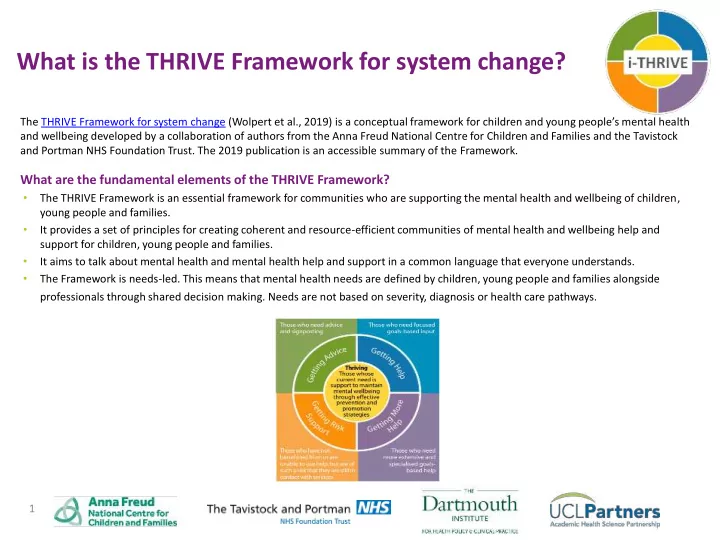

What is the THRIVE Framework for system change? The THRIVE Framework for system change (Wolpert et al., 2019) is a conceptual framework for children and young people’s mental health and wellbeing developed by a collaboration of authors from the Anna Freud National Centre for Children and Families and the Tavistock and Portman NHS Foundation Trust. The 2019 publication is an accessible summary of the Framework. What are the fundamental elements of the THRIVE Framework? • The THRIVE Framework is an essential framework for communities who are supporting the mental health and wellbeing of children, young people and families. • It provides a set of principles for creating coherent and resource-efficient communities of mental health and wellbeing help and support for children, young people and families. • It aims to talk about mental health and mental health help and support in a common language that everyone understands. • The Framework is needs-led. This means that mental health needs are defined by children, young people and families alongside professionals through shared decision making. Needs are not based on severity, diagnosis or health care pathways. 1
What is the THRIVE Framework for system change? Who does the THRIVE Framework relate to? • All children and young people aged 0 – 25 within a specified locality, and their families and carers. • Any professionals who seek to promote mental health awareness and help children and young people with mental health and wellbeing needs or those at risk of mental health difficulties (whether staff in educational settings, social care, voluntary or health sectors or others). What does the THRIVE Framework mean for children and young people in practice? • No ‘wrong door’, meaning that anyone that a child or young person talks to about their mental health, whether they are a teac her, a GP or school lunchtime assistant, are able to provide them with support, or at the very least, signpost them to available support options. • Whoever is helping a child or young person with their mental health knows the best ways to ask for their views about what is important to them and what they want to be different, so that there is genuine shared decision making about ways of helping. • Signposting the child or young person, and their family and friends, to ways that they can support their mental health and wellbeing needs. • Whoever is giving a child or young person more specialised mental health help will support the child or young person to evaluate their progress towards their goals and check that what is being tried is helping. • Supportive but transparent conversations about what different treatments are likely to lead to, including their limitations. 2
What is the THRIVE Framework for system change? What are the key principles of the THRIVE Framework? The conceptual framework, and its five needs based groupings: Thriving, Getting Common Advice and Signposting, Getting Help, Getting More Help, Getting Risk Support, Language supports a shared language and understanding across the system. Approach based on meeting need, not diagnosis or severity. Explicit about the definition of need at any one point, what the plan is and everyone’s role within that plan. Needs-Led Fundamental to this is a common understanding of the definitions of the needs based groupings across the local system. Voice of children, young people and families is central. Shared decision making Shared Decision processes are core to the selection of the needs based grouping for a given child or Making young person. Enabling the whole community in supporting mental health and wellbeing. Proactively Proactive working with the most vulnerable groups. Particular emphasis on how to help children, Prevention and young people and their communities build on their own strength including safety Promotion planning where relevant. 3
What is the THRIVE Framework for system change? What are the key principles of the THRIVE Framework? Partnership Effective cross-sector working, with shared responsibility, accountability and mutual Working respect based on the five needs based groupings. Clarity and transparency from outset about children and young people’s goals, Outcome measurement of progress movement and action plans, with explicit discussion if Informed goals are not achieved. Ensuring mental health and wellbeing is everyone’s business. Reducing Stigma Advice, help and risk support available in a timely way for the child, young person or Accessibility family, where they are and in their community. 4
Recommend
More recommend